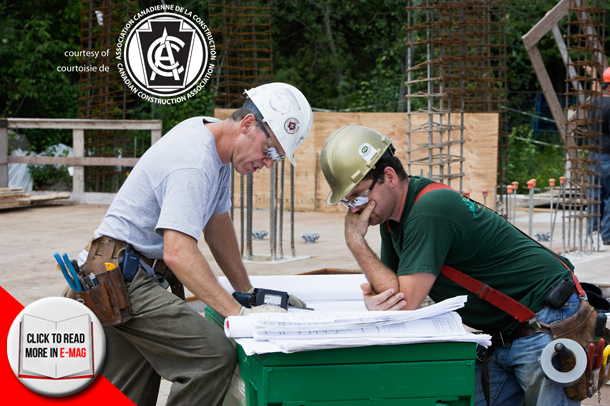Voice of Canada’s construction industry
By: Mudeeha Yousaf
The construction industry is in a constant state of flux as past common practices quickly become obsolete. These ongoing market fluctuations produce new opportunities and highlight Canada’s growing global resilience. Helping navigate the industry through these ebbs and flows is the Canadian Construction Association (CCA). The association represents more than 20, 000 members across Canada through its network of more than 69 local and regional partner associations, collectively working on behalf of the non-residential construction sector to improve standard documents, industry practices and the public policy environment across Canada.
HISTORY
The CCA was born in 1918 and with the goal to improve procurement and contractual practices across Canada. While these goals remain core to the association, CCA has also become very active in lobbying for important changes to federal public policy in support of industry priorities. “When government officials are seized with new policy development, we work alongside them to ensure that the industry’s views are taken into account and that adverse impacts resulting from the change in policy are minimized,” says Pierre Boucher, Chief Operating Officer who has been with the CCA since 1988. “Often times the government will consult with us and we’re happy to oblige and provide the best information we have at our disposal.” Infrastructure funding, training, labour mobility, trades, immigration and sustainable development are just some issues the CCA is involved in.
CORE FUNCTION
As well, the CCA develops standard contract documents using The Canadian Construction Documents Committee (CCDC) – a national joint committee responsible for the development of standard Canadian construction contracts – as its guide. The association works with owners, consulting engineers, architects as well as contractors to develop unbiased contract forms so they are fair for all parties. “Whenever you sign a contract there’s a lot at risk, so you want contractual documents that are fair to all parties and will limit disputes in liability,” says Boucher. Also issuing guides with the use of the forms to answer any and all inquiries, the documents are used for design-build, P3 or traditional lump sum projects and available to all members.
The CCA has been active in the promotion of inter-provincial mobility and remains dedicated to the development of national industry-workforce training standards. “The core function of the CCA has not changed dramatically since our inception,” says Boucher. “We work with governments to make sure there are funds for training purposes that the provinces will have to manage and bring about the best training systems possible. For example, when you have major investments in infrastructure, it must serve the whole economy, as well as the firms dedicating their lives to improving our infrastructure.”
“NEW CULTURE FOR INNOVATION”
With strong support from CCA, Canadian Construction Innovation launched this year with a mission to promote leading-edge construction research and innovation to Canada’s construction industry. “The goal is to bring about a new culture for innovation and the commercialization for new innovative solutions in the industry that will increase efficiencies and productivity to facilitate the modernization of the way things are built,” says Boucher. “Soon enough it will be in full operation, and we’ll start seeing some major differences.”
In addition, the association continues to play a strong role in the development of standards related to emerging technologies. One such example would be the Institute for BIM in Canada, which has been working on a series of documents, including case studies and contract language that will soon be released with the goal of facilitating the uptake of BIM practices by the industry across the country. The CCA is undertaking a series of seminars this April and May where owners, engineers, architects, manufacturers and suppliers can gain knowledge about how best to get involved with BIM and will create joint responsibility. “You go from paper, to mail, to fax, to email… The next generation will come with more peripheral tools that will facilitate design in 3D and 4D and will bring about a need for people to work close together.”
PRO-ENVIRONMENTAL
The construction sector has always been responsive to sustainable practices in building, but the CCA argues there are many ways to serve the environment beyond LEED. “We like to think the CCA is pro-environmental, and we’re here to promote practices that contribute to a healthier overall environment.” The association works with governments at all levels to promote best-practices and mitigate the release of environmental pollutants. “While we are not the ultimate owner of the facility, we can influence its long-term emissions profile by working with owners to implement pollution mitigation systems that over the life of the asset will significantly reduce its environmental footprint.”
TRENDS
“The single greatest challenge facing the industry today is workforce scarcity. With increasing retirements and growing demand for construction services across Canada, the industry will need to recruit 300,000 new workers over the next 7 years,” says Boucher. “Immigration is part of the solution and we continue to work with government officials to ensure Canada’s immigration system is open and permits construction employers to access qualified skilled labour the industry needs from abroad. While this is never the preferred solution, increasing domestic skilled trade’s scarcity is leaving the industry with little choice.”
With globalization increasingly impacting every sector of the Canadian economy, Canada can ill afford to fall behind due to chronic workforce shortages. “We’ll have to be versatile and efficient in order to sustain our enviable way of life. To that end, we believe Canada must continue to invest in a system of world-class public and private infrastructure in order to remain globally competitive.” Boucher advocates that “the world as we know it will change and we have to be proactive in ensuring Canada is not left behind.”
With a history spanning close to 100 years, The Canadian Construction Association is “proud to have accomplished what we have over the years. We are very strong and well represented and have a good system and structure in place. We do the best we can to serve the industry in Canada as a whole.”
For more information on the CCA, visit www.cca-acc.com







